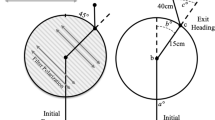Summary
Leptothorax unifasciatus workers use both chemical and visual cues when foraging. A visual orientation based on menotactical cues (60 watt light-bulb) and environmental cues (laboratory surroundings) dominate over a chemical orientation. The learning response to a 60 watt light-bulb cue occurs after a single trip to the food source.
Workers lay down a trail when foraging which helps them to orient themselves but does not recruit other nestmates. Such trails are distinguished and preferred even when superposed by several other nestmates' trails. Nevertheless, the foragers are able to follow their nestmates' trails if their own is somehow missing. Newly recruited ants are unable to orient along chemical trails.
Resume
Les ouvrières deLeptothorax unifasciatus utilisent des repères chimiques et des repères visuels au cours des activités de fourragement. Cependant, une orientation ménotactique (ampoule lumineuse de 60 watt) et reposant sur des repères visuels ambiants domient une orientation chimique. Un trajet effectué vers la nourriture suffit aux ouvrières pour s'orienter ensuite sur une ampoule lumineuse.
Les ouvrières tracent une piste au cours du fourragement n'ayant pas fonction de recrutement, mais agissant comme repère orientationnel individuel. Ces pistes sont distinguées et préférées même lorsqu'elles sont superposées à plusieurs autres. Néanmoins, les ouvrières acceptent de suivre les pistes de leurs congénères en l'absence de leur propre piste. Les ouvrières nouvellement recrutées sont incapables de s'orienter sur les pistes chimiques.
Similar content being viewed by others
References
Aron S., Pasteels J.M., Deneubourg J.L., Boeve J.L., 1986. — Foraging recruitment inLeptothorax unifasciatus: The influence of foraging area familiarity and the age of the nest-site.Insectes Soc., 33, 338–351.
Breed M.D., Harrison J.M., 1987. — Individually discriminable recruitment trails in a ponerine ant.Insectes Soc., 34, 222–226.
Deneubourg J.L., Aron S., Goss S., Pasteels J.M., Duerinck G., 1986. — Random behaviour, amplification processes and number of participants: How they contribute to the foraging properties of ants. Proc. Los-Alamos conf. on Games, Learning and Evolution.Physica, 32, 109–116.
Fresneau D., 1985. — Individual foraging and path fidelity in a Ponerine ant.Insectes Soc., 32, 109–116.
Hahn M., Maschwitz U., 1985. — Foraging strategies and recruitment behaviour in the European harvester antMessor rufitarsis (F.).Oecologia (Berl.),68, 45–51.
Henquell D., Abdi H., 1981. — Influence respective des repères visuels et des repères chimiques dans l'orientation deFormica polyctena au cours de l'exploitation d'une source de nourriture.Insectes Soc., 28, 47–66.
Hölldobler B., 1971. — Homing in the Harvester antPogonomyrmex badius.Science, 171, 1149–1151.
Hölldobler B., 1976. — Recruitment behavior, home range orientation and territoriality in harvester ants,Pogonomyrmex.Behav. Ecol. Sociobiol., 1, 3–44.
Hölldobler B., 1980. — Canopy orientation: A new kind of orientation in ants.Science, 210, 86–88.
Hölldobler B., Möglich M., Maschwitz U., 1974. — Communication by Tandem Running in the antCamponotus sericeus.J. Comp. Physiol., 90, 105–127.
Jander R., 1957. — Die optische Richtungsorientierung der Roten Waldameise (Formica rufa).Z. Vergl. Physiol., 40, 162–238.
Jessen K., Maschwitz U., 1985. — Individual specific trails in the antPachycondyla tesserinoda (formicidae, Ponerinae).Naturwissenschaften, 72, 549–550.
Jessen K., Maschwitz U., 1986. — Orientation and recruitment behavior in the ponerine antPachycondyla tesserinoda (Emery): laying of individual-specific trails during tandem-running.Behav. Ecol. Sociobiol., 19, 151–155.
Lane A., 1977. — Recrutement et orientation chez la fourmiLeptothorax unifasciatus (Latr.): Rôle de la piste et des tandems.Thèse de 3 e cycle (Dijon), pp. 124.
Maschwitz U., Lenz S., Buschinger A., 1986. — Individual specific trails in the antLeptothorax affinis (Formicidae: Myrmicinae).Experientia, 42, 1173–1174.
Möglich M., 1975. — Recruitment ofLeptothorax. Proc. symp. I.U.S.S.I., Dijon, 235–242.
Möglich M., 1979. — Tandem-calling pheromone in the genusLeptothorax (Hymenoptera, Formicidae). Behavioral analysis of specificity.J. Chem. Ecol., 5, 35–51.
Möglich M., Maschwitz U., Hölldobler B., 1974. — Tandem-calling: A new kind of signal in ant communication.Science, 186, 1046–1047.
Möglich M., Hölldobler B., 1975. — Communication and orientation during foraging and emigration in the antFormica fusca.J. Comp. Physiol., 101, 275–288.
Passera L., 1984. —L'organisation sociale des fourmis. Eds, Privat, pp. 360.
Pasteels J.M., Deneubourg J.L., Goss S., 1987a. — Self-organization mechanisms in ant societies (I): trail recruitment to newly discovered food sources.In,Pasteels J.M. andDeneubourg J.L. (eds).From individual to collective behavior in Social Insects, Birkaüser Verlag, 155–175.
Pasteels J.M., Deneubourg J.L., Goss S., 1987b. — Transmission and amplification of information in a changing environment: the case of Insect Societies.In, Prigogine I andSanglier M. (eds).Laws of nature and human conduct, G.O.R.D.E.S., Brussels, 129–156.
Roisin Y., 1982. — Eco-ethologie de l'approvisionnement du nid chez lesTetrammorium belges (Hym. Formicidae).Mémoire de licence, Bruxelles, pp. 79.
Siegel S., 1956. — Non-parametric Statistics for the BehavioralSciences. Mc Graw-Hill, New York, pp. 312.
Traniello, J., 1987. — Social and individual responses to environmental factors in ants.In Pasteels J.M. andDeneubourg J.L. (eds),From individual to collective behavior in social Insects. Birkaüser Verlag, 63–80.
Wehner R., 1969. — Homing in the antCataglyphis bicolor.Science, 164, 192–194.
Wehner R., 1977. —Cataglyphis, Endeavour, 1, 3–4, 115–121.
Wehner R., Duelli P., 1971. — The spatial orientation of Desert antsCataglyphis bicolor, before sunrise and after sunset.Experientia, 27, 1364–1366.
Wilson E.O., 1962. — Chemical communication among workers of the fire antSolenopsis saevissima (Fr. Smith). I. The organization of mass-foraging. II. An information analysis of the odour trail. III. The experimental induction of social responses.Anim. Behav., 10, 134–164.
Author information
Authors and Affiliations
Rights and permissions
About this article
Cite this article
Aron, S., Deneubourg, J.L. & Pasteels, J.M. Visual cues and trail-following idiosyncrasy inleptothorax unifasciatus: An orientation process during foraging. Ins. Soc 35, 355–366 (1988). https://doi.org/10.1007/BF02225811
Received:
Accepted:
Issue Date:
DOI: https://doi.org/10.1007/BF02225811




